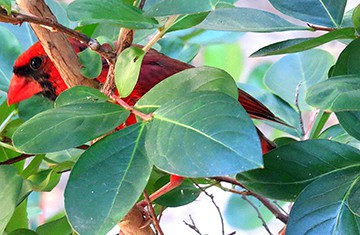 Photo ©
Carolyn Mathur
Photo ©
Carolyn Mathur
Do Bird-Friendly Yards Attract Predators?
As more bird enthusiasts replace their lawns with bird-friendly plantings like trees and shrubs, they might be concerned about attracting nest predators into the area. Though nest boxes can be equipped with predator guards, most open cup nests, like those of Northern Cardinals and American Robins, cannot be.
Researchers from The Ohio State University and the Cornell Lab of Ornithology investigated whether there was a link between woody vegetation (i.e., trees and shrubs) and predator activity by conducting a study in several Ohio neighborhoods. The researchers surveyed for common nest predators in backyards, and looked for a relationship to the amount of woody vegetation. Common nest predators at the studied sites in Ohio included Eastern gray squirrel, Common Grackle, Brown-headed Cowbird, Blue Jay, and domestic cat (among others).
What they found was unexpected. Even though many nest predators use woody vegetation, bird-friendly landscaping did not attract predators. Yards and neighborhoods with more mature trees and shrubs were no more likely to have high predator activity than yards without. Their findings suggest that increasing the amount of shrubbery and trees in suburban yards does not encourage increased activity of nest predators. So with that in mind, feel free to check out our tips for landscaping for nesting birds.
Reference: Malpass, J.S., Rodewald, A.D., and Matthews, S.N. 2015. Woody cover does not promote activity of nest predators in residential yards. Landscape and Urban Planning 135: 32-39.
 Photo ©
Photo ©